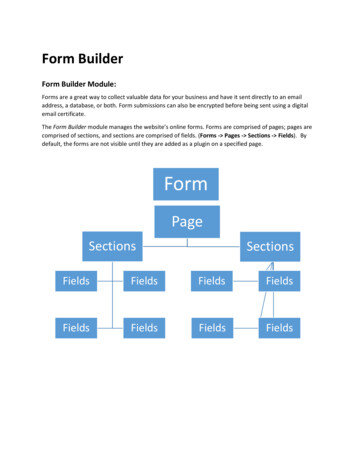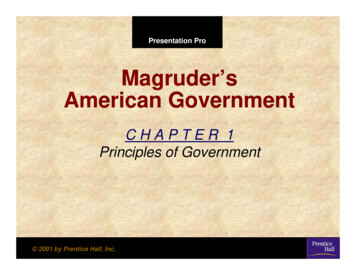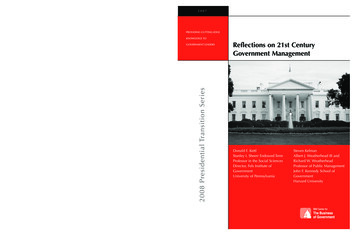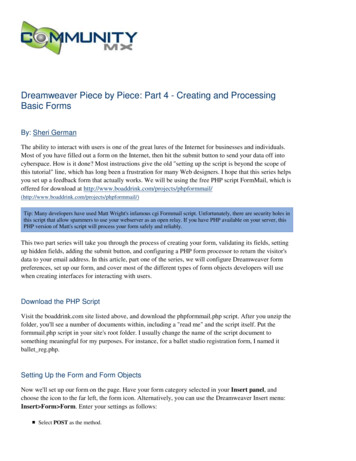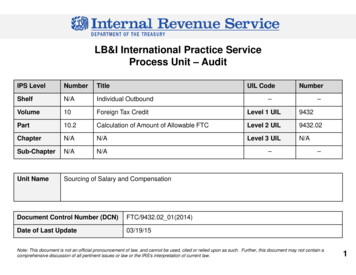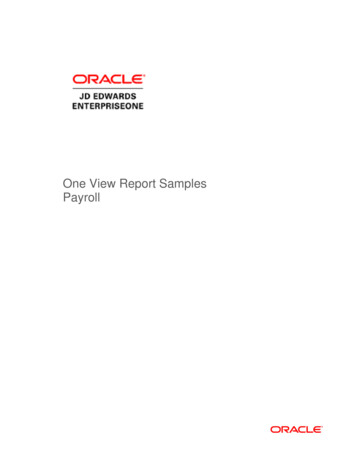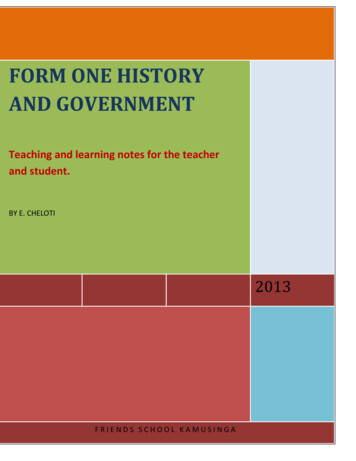
Transcription
FORM ONE HISTORYAND GOVERNMENTTeaching and learning notes for the teacherand student.BY E. CHELOTI2013FRIENDS SCHOOL KAMUSINGA
TEACHING AND LEARRNING NOTES FOR FORM ONE KNEC SYLABUSINTRODUCTION TO HISTORY AND GOVERNMENTTHE MEANING OF HISTORYHistory is an account of events that took place in the past.History may also be defined as a branch of knowledge which deals with past events of humanbeings and their response to their environment over the years.R.G Collingwood, in his book The Idea of History (OUP 1994) defined history as a “scienceconcerned with the human actions in the past, pursued by interpretation of evidence for thesake of Human self knowledge”That history is a science because it involves finding out things about the past Humankind. Forexample; the origin of Man, why he was a toolmaker, why he domesticated animals and plants.These are questions that provoke scientific curiosity.The three definitions of History from the above are; History is the past of anything; of earth, man, disease or animals History is a branch of knowledge dealing with past events History is a science concerned with past Human actionsSince History at secondary level is specifically concerned with the past as it relates tohumankind and his response to his environment over the years, the working definition ofhistory is therefore; History is the endless story of mankind’s actions and events affecting him in the past.Closely related to the term history is the term PREHISTORY.Prehistory refers to the unrecorded history- those activities that humans engaged in beforewriting and drawing were invented as ways of storing information. Such information is gainedfrom songs, myths, stories, artefacts, fossils and the language of a people.A historical event needs to have recorded evidence in order to be referred to as a historical factCharacteristics of historical events. They must have evidence. Historical information must be written or unwritten. Historical events only concern man. Historical events dwell mainly on the past happenings. Historical events must contain elements of truth.The study of humankind’s past can be classified systematically into three; Social history- dealing with the traditions, values and cultural practices of a people Economic history; dealing with the means of livelihood of a people, such as hunting,gathering, agriculture and trade. Political history; dealing with the control system in a society, for example maintenanceof law and order, leadership and security.THE MEANING OF GOVERNMENTDerived from the verb govern, government means to exercise authority over. To rule, orcontrol. Or having power to direct or conduct the policies and public affairs of a country or aninstitution.Key notes for the teacher and students- @Cheloti 2012-20132
TEACHING AND LEARRNING NOTES FOR FORM ONE KNEC SYLABUSIn our study, the term government refers to a group of people within a state or a country givenauthority to organize, direct and control the affairs of the state or country.In Kenya, the government has three arms.The legislature: - Commonly referred to as parliament, this is a law making arm of government.It includes the National assembly and the president.The executive: - this is the arm of government which implements laws. It includes thepresident, the cabinet and the civil service.The judiciary: - this is the arm of government responsible for seeing that the laws made areconstitutional, that they are followed and that those who break them are punished. It iscommonly referred to as the courts.Jean Jacques Rousseau, in his book, The Social Contract, he describes government as “anintermediate body set up by the subjects to ensure equity (fairness) and the execution of lawswhile maintaining social and political liberty”In this sense, government is not dictatorial since its authority is derived from the people. Peoplemust however be free to choose their leaders, even remove those in power and replace themwith others, in order to ensure the existence of the principal of fairness.FORMS OF GOVERNMENTThere are four forms of government:Democratic government.This is a type of government in which rulers regularly seek public mandate through popularvote. Such governments are based on the principles of free and fair elections.According to Abraham Lincoln, an American statesman, they are “governments of the people,for the people and by the people”.In such a government, freedoms and rights are provided for in the constitution that governs thelaw of the nation.Aristocratic governmentAristos – bestKratos - powersAn aristocracy is a form of government in which a group of people from the highest social classthe royalty- in a society rule over others. Any member of the nobility can seek election orappointment to a government office while other citizens who are less privileged are there to beruled.The King or Queen is the head of government while senior positions in the government aregiven to the privileged members from among the nobles. The nobles are considered superior toothers human beings because of the wealthy family background they are born into and theirsuperior education. They are considered a rare breed of people.Monarchical governmentThis is a form of government where democracy is practiced but aristocratical power isrespected. Parliament is the supreme organ but the monarchy- the royalty that are in powerbe it the king or queen is retained as a tradition, and respected as head of state.Monarchical governments are classified into two;Absolute monarchy:- which refers to the unrestricted power of the Head of State. Themonarchy is dictatorial.Key notes for the teacher and students- @Cheloti 2012-20133
TEACHING AND LEARRNING NOTES FOR FORM ONE KNEC SYLABUSConstitutional monarchy;- The monarchical power , which is restricted is determined by what isspelt out in the constitution. Such a system of government is found in Lesotho and Britain.Dictatorial government.Dictatorship is a system of government where the ruler has total power over his subjects.Dictators are the sole authority where they rule. They make the law and execute justice andexercise their rule forcefully, suppressing their subjects at will. They curtail freedom of othersubjects and impose their will over others.Examples of world dictators; Adolf Hitler of Germany who instigated the Germans into believingthey were superior race and incited them against the Jews. Idi Amin of Uganda who ruled witha ‘rod of iron’NB; the most ideal form of government is where the subjects go to the ballot to elect thepeople to lead them. Governments play the important function of maintaining law and order.Importance of studying historya) History enables us to appreciate people’s evolution, origin of cultures and development andhence further good relations and remove biases and prejudices about other people.b) When we study history, we appreciate people’s contribution to national development. E.g.freedom fighters hence the importance of mutual and social responsibility.c) It helps us to know the origin of mankind, his development and the progress he has madeto this day.d) We are able to understand our culture and appreciate the culture of other people.e) it instills a sense of patriotism and nationalism among citizens as they learn of the pastpolitical developments of their country. Its study inspires strong feelings of one’s heritageand the sense of belonging to a particular country.f) It helps us understand the interdependence of mankind and hence the need forcooperation.g) It influences career choice. The study of history leads to various professions. E.g. law,diplomacy, church, politics, teaching, and administration.h) The study of history helps us comprehend the social, economic and political developmentsof our societiesi) It gives time and space to past events. Through the study of history, we learn about thetime and place where an event took place. E.g. we know when Mau Mau uprising broke out(1948) and know when Kenya gained independence.j) It helps us develop a critical mind as we try to explain historical events. Historians will askwhy, when and how.k) It provides intellectual fulfillment to the learner. Through an in-depth study of history, one’smind is enriched.Importance of studying government.a) It helps us to appreciate the importance of government.b) Helps us understand how laws are made and enforcedc) Helps us understand the organs of the state and the powers vested in themd) Helps us understand how government raises and spends revenue.e) Helps us compare our government system with other systems of government in otherKey notes for the teacher and students- @Cheloti 2012-20134
TEACHING AND LEARRNING NOTES FOR FORM ONE KNEC SYLABUSf)g)h)i)j)countries.Understand how development policies are formulated and implemented.It makes us know our roles as citizens and the roles of the leaders who govern us. Thismakes better law-abiding citizens.Its study helps us understand our responsibilities as well as the limitations within which emust operate for the well-being of every member of the society.It helps us appreciate the constitution and the process of making and reviewing laws andstatutes.It influences career choices. For example, those who choose to specialize in publicadministration will find the study of government very useful.SOURCES OF INFORMATION ON HISTORY AND GOVERNMENTThere three main sources of information on history and government;a) Unwritten sources.b) Written sources.c) Electronic sourcesUnwritten sources.This refers to historical information which is not recorded in writing.Unwritten sources of historical information include oral traditions, linguistics (languages),anthropology (culture) archaeology, palaeontology and genetics.Oral traditions.This refers to the practice of handing down historical information by word of mouth from onegeneration to the next. This forms a very important source of historical information especiallywhere exists a non-literate society who might not be able to read.Oral traditions include folk tales, proverbs, songs and stories. Songs, proverbs folktales andstories told to a younger generation have been very instrumental in the passing of informationfrom one generation to the other. For example, a song about our struggle for independence inKenya passes very important information to the younger generation, who not yet had born atthat time.Advantages of oral traditions as a source of information.a. Oral traditions hands over historical facts from one generation to another in the absence ofwritten records.b. It is the best source of historical information since even the illiterate can learn their historyusing oral traditionsc. It is also a form of entertainment. For example through songs, folktales stories andproverbs, people get entertained.d. It complements other sources of information.e. The source of information is captivating especially if it is narrated by a person whoparticipated in the event himself. For example an Ex- World War II veteran narrating aboutthe war.Disadvantages of oral traditions as a source of information.Key notes for the teacher and students- @Cheloti 2012-20135
TEACHING AND LEARRNING NOTES FOR FORM ONE KNEC SYLABUSa. The truth and correctness of oral traditions become unreliable especially when the narratordeliberately conceals some information or lies. People tend to conceal their failures whiletalking so much about their success.b. Information can b exaggerated as they are transmitted by elders to successive generations.At times it is difficult to differentiate between what is real and what is imagined.c. Some information or facts may be forgotten or omitted since oral traditions depend heavilyon human memory. This makes the information passed unreliable.d. Dates of information may be lacking. The source may not give correct chronology of eventsbecause it depends on human memory. It is common that people forget important datesand information about a particular past event.e. It is an expensive method. One has to pay for the informant’s transportation, lunch andaccommodation. A historian may also need to travel to far places to find information.f. It is time consuming. One requires a lot of time to interview one individual. Where manypeople are to be interviewed, it may take a long time.Linguistics.This refers to the scientific study of languages.Historical linguistics is the study of language as it changes n the course of time. It seeks to tracethe principles of language change and establish the current genealogical classification of aparticular languageSuch a study helps in discovering language form, content, vocabulary and historical experiencesof the people who speak the language.Distribution of language and relationship between languages is important to a historian. Peoplewho speak related languages may be assumed to have a common origin, be connected, or hadbeen in close contact at sometime in the past.Variations between languages of the same family can show how long ago the break in contactoccurred.Advantages of linguistics as a source of information.a. Through linguistics, Facts can be obtained about the movement of people and theirrelationship. Such information helps experts to correctly group languages according tolanguage families.b. It helps us understand communities better as people with a common language may havecommon origin. It is good for establishing facts on origin, migration and settlement.c. Linguistics complements other sources of historical information. For example, language as amedium of communication helps those using oral tradition to gather information fromvarious sources.d. Language has enabled historical linguists to discover links between different people whichwere previously unknown. E.g. it is now known that the Bantus had a common origin andpossibly spoke one language. However due to long periods of separation between variousBantu groups, through migrations, these groups may not understand each other’s languagetoday.e. Linguistics helps in the dating of migration of people. Language drawn from a parentlanguage will change in a certain way and rate through time. When comparing parentlanguage with derived language, it is possible to know how long the derived language hasKey notes for the teacher and students- @Cheloti 2012-20136
TEACHING AND LEARRNING NOTES FOR FORM ONE KNEC SYLABUSdeveloped independently from the parent language. E.g. Sheng language andKiswahili(parent language)Limitations in the use of linguistics as a source of informationa. It is time consuming/learning a language takes a long time therefore delaying acquisition ofinformation.b. There is a danger of omitting a word when translating a language. In the process, vitalinformation about a people’s history may be lost.c. Inaccurate information can be passed on where wrong words are borrowed from otherlanguages.d. Some words may just be difficult to understand.e. Some languages have become archaic and irrelevant hence difficult to translate.f. Misinterpretation of words may make them difficult to understand.g. Linguistic analysis for classification purposes may fail to take into account languages withtime.h. One word may have different meanings in different languages. This can easily confuse aresearcher. For example, Nyoro in Kikuyu means ‘smooth’, while the same word in Luomeans ‘yesterday’.i. Lack of original speakers in the language under study limits research findings.AnthropologyThis is the study of human beings, their origin, development, customs, beliefs, and socialattributes like music, dance, drama, and religious beliefs and practices.Anthropologists have to live among the people under study in order to experience their way oflife in order to understand and explain structures of societies, forms of social organization,institutions, descent, marriage, forms of government, systems of inheritance, religious customsand cultural values.The anthropological description of the beliefs and customs of a people will help the historian todetermine the cultural past of the peopleAdvantages of anthropology as a source of information.a. By living among the people, anthropologists help to discover, understand and explainstructures of societies, forms of social organization, cultures, etc.b. Anthropologists assist historians to determine the cultural past of the people.c. It also gives a deeper understanding of a particular aspect of a people’s culture.Limitations in the use of anthropology as a source of informationa. It is an expensive method as it involves living among the people.b. It is a time-consuming method of acquiring information.c. It is difficult for a researcher to adapt to the environment since the people they are studyingmay be of a totally different culture. Where they succeed in adapting, they face the risk oflosing their own culture.d. People under study may try to behave differently when the researcher is around. Aresearcher may therefore miss important details.Genetic studies.Genetics is the scientific study of the ways in which characteristics are passed from parents totheir offspring. (The study of heredity and the variation of inherited characteristics.) It dealsKey notes for the teacher and students- @Cheloti 2012-20137
TEACHING AND LEARRNING NOTES FOR FORM ONE KNEC SYLABUSwith the ay human beings adapted to the circumstances in their environment and utilizedavailable plants and animals to meet their needs.When used in relation to pants genetic studies helps us trace the origin of various species byidentifying them with the region where large numbers of them are found today. After this,interpretation of their movement is made. The appearance of new cultivated varieties can beidentified with the people whose economy they form a part. Also, common genes orcharacteristics among a group of people may indicate some relationships.Archaeology and palaeontology.Archaeology is the study of man’s past through scientific analysis of the remains of materialremains of his culture, e.g. weapons, tools, houses, clothing, utensils, paintings sculpture,pottery, coins, jewellery, cutlery, beads and work o arts.The archaeologist reconstructs the activities and way of life of people who lived in prehistorictimes from various evidence remains of the material culture.Other items that can be used in archaeology include remains of charcoal and carbonized seeds,remains of cloth or garments, remains of dwelling laces.After studying the available artefacts, the archaeologist formulates his concept of a people’scivilization at the time the artefacts were used. The existence of artefacts in an area can enablethe historian to deduce the material culture of the people who lived n the past.Palaeontology is the scientific study of the evolution and structure of extinct plants and animals(fossils) through scientific examination of fossil remains.Historians and archaeologists work with natural scientists like paleontologists, geologists andecologists and chemistry in discovering fossils, getting information about soil structure,interpreting man’s relationship to his environment and dating of fossils.Methods used by archaeologists and paleontologists in discovering a historical site.a) By looking at areas where tectonic forces (faulting) or erosion have occurred. In such areas,surfaces which may give important clues to the point of finding fossils and artefacts areexposed.b) Use of vision. Sometimes vision may help them find on the surface a small part of an earlysettlement such as a few stones in a regular pattern.c) Use of historical research. A place that may be mentioned in a historical document or in anoral narrative may give a clue to the geography of the area and open up further inquiriesinto the past civilization of such a clue.e.g Omo River Valley, Olduvai Gorge, Ur and Babylon.d) Use of experience. An archaeologist may also use his long experience and skill to identify apotential site for archaeological excavation.e) During cultivation and building construction, farmers and builders may accidentally exposeancient objects that could arouse the curiosity of researchers. For example ‘Nyayo yaMungu’ in Tanzania was a single footprint on a rock surface that was found in 1995 andbecame evidence of the existence of early human beings.Advantages of using archaeology.a) Archaeology gives us detailed information on material culture that other sources may nothave.b) Archaeology gives a sense of time, as the artefacts are dated.Key notes for the teacher and students- @Cheloti 2012-20138
TEACHING AND LEARRNING NOTES FOR FORM ONE KNEC SYLABUSc) It complements other sources of information and thus ensures authenticity of theinformation.d) It provides information of varied nature depending on the materials found on the site. Forexample, if tools, weapons, coins, bones, rock paintings and other items are located, at asite, a lot of information maybe deduced.Limitations of using archaeologya) It is an expensive source of information. This is because one has to hire labourers toexcavate the site and get artefacts and take them to laboratories for analysis.b) It is a time-consuming method. The researcher needs a lot of time to prepare for anexcavation and take material for analysis in laboratories.c) It is sometime difficult for archaeologists to locate an archaeological site.d) Some artefacts and fossils are fragile and can therefore break or disintegrate duringexcavation. This may result in distortion of the analysis of the artefacts.e) Archaeology is only limited to the study of the ancient period and therefore cannot be usedto study recent history.f) Archaeological information may sometimes be inaccurate since it is often bases oninferences (conclusions) and reconstructions.g) With archaeology, it may not be easy to accurately determine the date when events tookplace. It is only estimated through the method of dating fossils.h) There are very few archaeological experts and facilities for interpreting archaeologicalevidence in Kenya. Quite often, artefacts excavated from Kenya are taken to Europeancountries for dating and analysis.What things do archaeologists use to construct the activities of people who lived in pre-historytimes?a) Looking for regions of tectonism (faulting) associated with fossils and artifacts.b) They look for unique features e.g. stone patterns.c) Remains of fossils and artifacts dug out by farmers and constructors.d) They dig, excavate for artifacts and fossils.e) They study artifacts and fossils found.f) They make research in regions associated with evolution of man e.g. rift valley.g) They classify the artifacts and fossils.h) They use chemical and scientific methods to find ages of their findings e.g. carbon 14dating methodWhat problems face archaeologists in their work of re writing history using unwritten sources?a) The exercise is too expensive.b) It is dangerous and tedious. Animals like wild dogs can attack scientists.c) Identification of the site is not easy because some artifacts are buried.d) Some artifacts can be destroyed in the process of digging.e) Dating of fossils is difficult.f) Personnel are few hence more work.g) Poor infrastructure in rural areas where their researches are mainly basedh) Archaeologists may suffer from diseases caused by changes in climate.i) Sometimes the climate of their residence differs from that of the place they are takingKey notes for the teacher and students- @Cheloti 2012-20139
TEACHING AND LEARRNING NOTES FOR FORM ONE KNEC SYLABUSresearch. This creates discomfort.METHODS OF DATING FOSSILSThere are six methods through which scientists may use to arrive at the age of fossils.1. Geological periodsThese are periods that have been given names by paleontologists and geologists for the pastages. They are characterized by the successive type of pants and animals found, and theclimatic changes.The recent period is the Holocene period which began 10,000 years ago at the end of thePleistocene.2. Chemical datingThey exist in two types:(a) Radio- carbon datingThis method involves a measure of the rate of decay of carbon -14 in fossils and organicsubstances. Carbon -14 is a naturally existing radioactive element (isotope) of carbon of relativeatomic mass fourteen and is found in the Carbon Dioxide which is present in the atmosphere.It is absorbed by plants and consequently by all living organisms during their lifetime. Whenplant or animal dies, absorption stops. Carbon -14 already absorbed begins to disintegrate at afixed rate from the time of death.If the amount of carbon -14 still remaining in an organic sample can be measured and related tothe content of the isotope in the modern plant or animal, the rate of decay will be known. Thedate at which the sample was buried will e known. The measurement tells us how long it issince the organism died.The unit of measuring is known as half-life- the number of years it takes for half the carbon -14to decay.However the accuracy of radio-carbon dating is limited to upto 40,000 years ago.(b) Potassium argon method.This is the method used to date volcanic ash. During volcanic eruptions, potassium is emitted.As soon as the potassium is deposited, the radio-active potassium-40 immediately begins todecay into the gas argon. It is assumed that the argon is retained in the mineral or rock unlessthere is earth movement.Given that the rate of decay of potassium is known, the amount of argon-40 compared with theamount of potassium, gives a direct measure of age.Because of the slower rate of decay of potassium than the decay of carbon-14, the potassium –argon method is used for dates ranging from hundreds of millions of years to 30,000 years.Recently methods have been developed for measuring the potassium and argon simultaneouslyon the same sample using nuclear.3. Stratigraphy.This is the study and interpretation of the layers of rock successively deposited at one place. Itis useful in determining dates for areas affected by sedimentation. Through Stratigraphy , ageological time-chart is obtained showing which rock was formed earlier or later.4. Fission-track datingThis is a method developed for dating Pleistocene samples. The ages of glass and othermineral objects estimated by observing the tracks made in them by the fission fragments ofKey notes for the teacher and students- @Cheloti 2012-201310
TEACHING AND LEARRNING NOTES FOR FORM ONE KNEC SYLABUSuranium nuclei they contain. It requires that Uranium must be present. The age obtaineddates from the time the object solidified. This method has been proved reliable by beingable to provide same reading from a sample of glass with a lump of pumice from OlduvaiGorge corresponding with the potassium –argon dates from the same layer.5. Lexico-statistics dating.Lexico-statistics is the statistical study of the vocabulary of languages with the intentions ofdetermining their ages and their historical links with other languages.The study is based on the assumption that all languages have a basic vocabulary which willchange slowly at a common rate for all languages at all times. The existence ofreconstructed vocabulary of the parent language in derivative languages shows therelationship between the two.Glottochronology, a subdivision of Lexico-statistics, attempts to establish that languages arehistorically related .by this method, there is an effort to express rates of languagedevelopment by formulae precise enough to enable dates when change occurred to becalculated6. Statistical dating.Through a system of averaging, the length of a generation can be determined for aparticular society and dates estimated for events associated with certain generations.If the number and names of successive age-sets are remembered, the same system ofaveraging can be used.Advantages of using unwritten sources of information on history and government.a) Information about people’s movement and relationship is given.b) It is very efficient where there still existed illiteracy and people could not write or read.c) It informs us of events in the absence of written materials.d) Data received is primary/ firsthand so accuracy is enhanced.e) Materials collected or excavated can be stored in museums for future reference.f) They create employment in museums where they are stored.g) Information not captured by written sources can be obtained from oral traditions.h) There is a sense of reality as it involves things that are seen and touched.i) Unwritten sources especially linguistics help in discovering the links between differentpeople, which were previously unknown.j) Detailed information on material culture may be obtained.k) Dating of the migration of people is more accurate in unwritten sources e.g. In linguistics.Written sourcesThese are sources in which letters or any other symbols have been put on the surface forthe purpose of communication. They include books, archives, constitutions, journals,novels, plays, newspapers, magazines, documentaries, dairies, annual reports, periodicaland paintings.Written sources are classified into two;a) Archives and early manuscripts.Archives are a collection of historical documents or records, especially those carryingclassified information of a government or an organization, which after a period of time areaccessible to the public.Key notes for the teacher and students- @Cheloti 2012-201311
TEACHING AND LEARRNING NOTES FOR FORM ONE KNEC SYLABUSThey are also places where government, public and other historical records are kept.-theyare resource centres for information.A manuscript is an author’s handwritten or typed text that has not yet been published. Earlymanuscripts include stone tablets and scrolls. The bible and Quran are based on these two.b) Printed sourcesThey include books, journals, novels, plays, newspapers, magazines, documentaries, dairiesand annual reports. Photographs employ both electronic and printing processes butbasically fall under printed sourcesWorks of
THE MEANING OF HISTORY History is an account of events that took place in the past. History may also be defined as a branch of knowledge which deals with past events of human beings and their response to their environment over the years. R.G Collingwood, in his book The Idea of History (OUP 1994) defined history as a science


